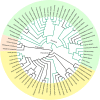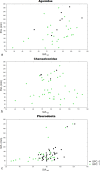Universality of indeterminate growth in lizards rejected: the micro-CT reveals contrasting timing of growth cartilage persistence in iguanas, agamas, and chameleons
- PMID: 31831851
- PMCID: PMC6908584
- DOI: 10.1038/s41598-019-54573-5
Universality of indeterminate growth in lizards rejected: the micro-CT reveals contrasting timing of growth cartilage persistence in iguanas, agamas, and chameleons
Abstract
Squamate reptiles are considered to exhibit indeterminate growth. Nevertheless, current literature disputes the available definitions of this growth type, presents new theoretical models, and questions its universality in cold-blooded vertebrates. We have followed up on our previous research employing micro-CT to explore growth plate cartilage (GPC) in the epiphysis of long bones, which is responsible for longitudinal skeletal growth by the endochondral ossification process. We focused on numerous and highly diversified group of the Iguania clade comprising Acrodonta (agamas and chameleons) and Pleurodonta ("iguanas"). We recorded the absence of GPC in most of the examined adult Pleurodonta specimens and interpret it as an irreversible arrest of skeletal growth. This finding clearly rejects the universality of indeterminate growth in lizards. On the other hand, we found apparent GPC preservation in most of the adult specimens belonging to Acrodonta. This suggests a preserved ability to continue body growth throughout most of their life. We discuss the uncovered disparity between Acrodonta and Pleurodonta and emphasize the importance of GPC degradation timing.
Conflict of interest statement
The authors declare no competing interests.
Figures



Similar articles
-
Determinate growth is predominant and likely ancestral in squamate reptiles.Proc Biol Sci. 2020 Dec 23;287(1941):20202737. doi: 10.1098/rspb.2020.2737. Epub 2020 Dec 23. Proc Biol Sci. 2020. PMID: 33352069 Free PMC article.
-
A new Late Cretaceous iguanomorph from North America and the origin of New World Pleurodonta (Squamata, Iguania).Proc Biol Sci. 2017 Jan 25;284(1847):20161902. doi: 10.1098/rspb.2016.1902. Proc Biol Sci. 2017. PMID: 28123087 Free PMC article.
-
Evolution of Karyotypes in Chameleons.Genes (Basel). 2017 Dec 12;8(12):382. doi: 10.3390/genes8120382. Genes (Basel). 2017. PMID: 29231849 Free PMC article.
-
Structure, formation and role of cartilage canals in the developing bone.Ann Anat. 2008;190(4):305-15. doi: 10.1016/j.aanat.2008.02.004. Epub 2008 May 28. Ann Anat. 2008. PMID: 18602255 Review.
-
Bone tissue and histological and molecular events during development of the long bones.Ann Anat. 2021 May;235:151704. doi: 10.1016/j.aanat.2021.151704. Epub 2021 Feb 16. Ann Anat. 2021. PMID: 33600952 Review.
Cited by
-
Latitudinal Clines in an Ectothermic Vertebrate: Patterns in Body Size, Growth Rate, and Reproductive Effort Suggest Countergradient Responses in the Prairie Lizard.Ecol Evol. 2024 Dec 23;14(12):e70680. doi: 10.1002/ece3.70680. eCollection 2024 Dec. Ecol Evol. 2024. PMID: 39717636 Free PMC article.
-
Development of male-larger sexual size dimorphism in a lizard: IGF1 peak long after sexual maturity overlaps with pronounced growth in males.Front Physiol. 2022 Aug 10;13:917460. doi: 10.3389/fphys.2022.917460. eCollection 2022. Front Physiol. 2022. PMID: 36035474 Free PMC article.
-
Life-History Traits of Eremias pleskei Nikolsky, 1905 from Northeastern Anatolia.Animals (Basel). 2024 Nov 23;14(23):3373. doi: 10.3390/ani14233373. Animals (Basel). 2024. PMID: 39682339 Free PMC article.
-
The first description of dermal armour in snakes.Sci Rep. 2023 Apr 19;13(1):6405. doi: 10.1038/s41598-023-33244-6. Sci Rep. 2023. PMID: 37076516 Free PMC article.
-
Growth Axis Somatostatin, Growth Hormone Receptor, and Insulin-like Growth Factor-1 Genes Express and Are Affected by the Injection of Exogenous Growth Hormone in Chinemys reevesii.Genes (Basel). 2023 Oct 31;14(11):2032. doi: 10.3390/genes14112032. Genes (Basel). 2023. PMID: 38002975 Free PMC article.
References
-
- Lincoln, R. J., Boxhall, G. A. & Clark, P. F. A dictionary of ecology, evolution and systematics. (Cambridge University Press, 1982).
-
- Reiss, M. J. The Allometry of Growth and Reproduction. (Cambridge University Press, 1989).
-
- Sebens KP. The ecology of indeterminate growth in animals. Annual Review of Ecology and Systematics. 1987;18:371–407. doi: 10.1146/annurev.ecolsys.18.1.371. - DOI
-
- Haines RW. The evolution of epiphysis and of endochondral bone. Biological Review. 1942;17:267–292. doi: 10.1111/j.1469-185X.1942.tb00440.x. - DOI
-
- Haines, R. W. Epiphysis and sesamoids. (ed Gans, C.) 81–115 (Academic Press, 1969).
Publication types
MeSH terms
LinkOut - more resources
Full Text Sources

